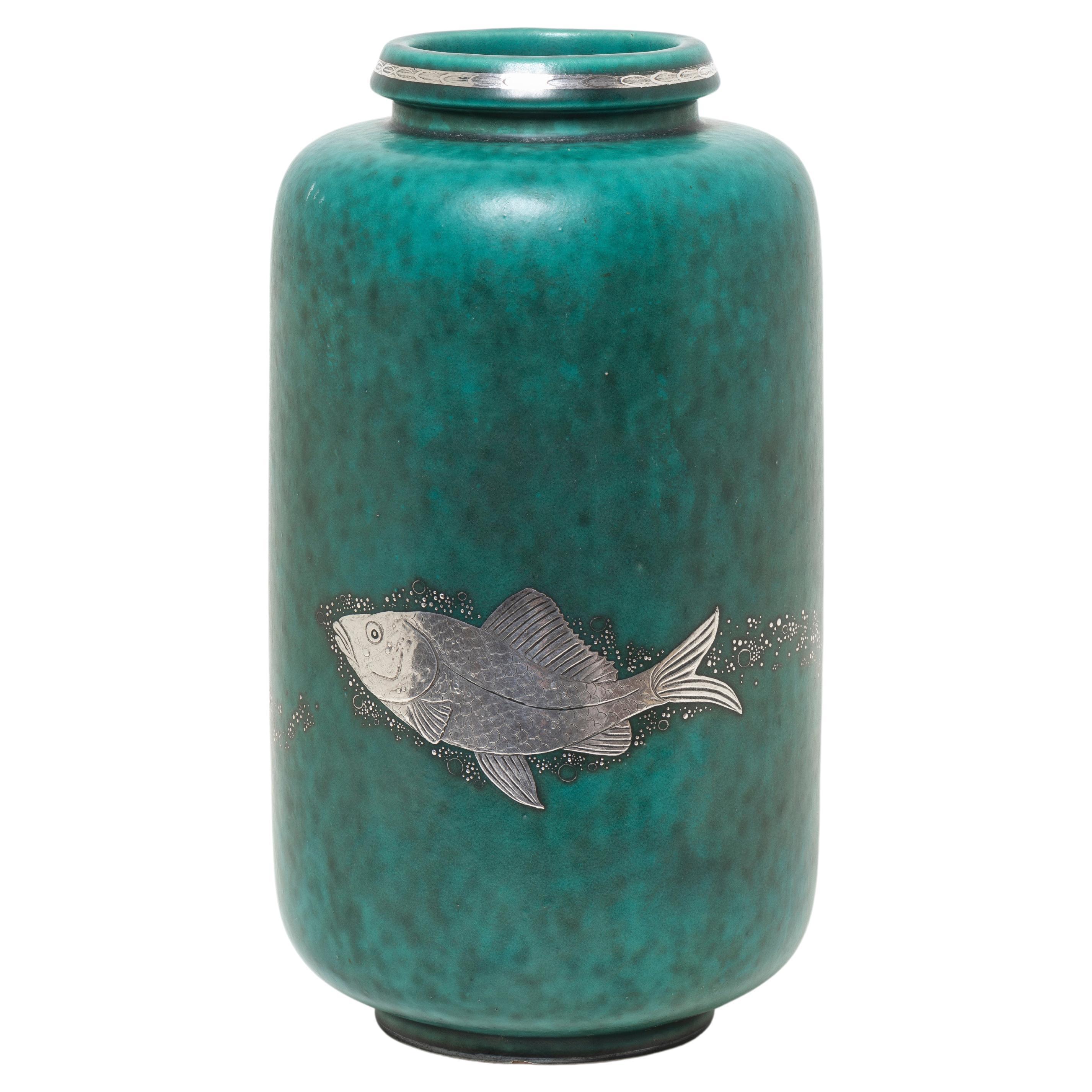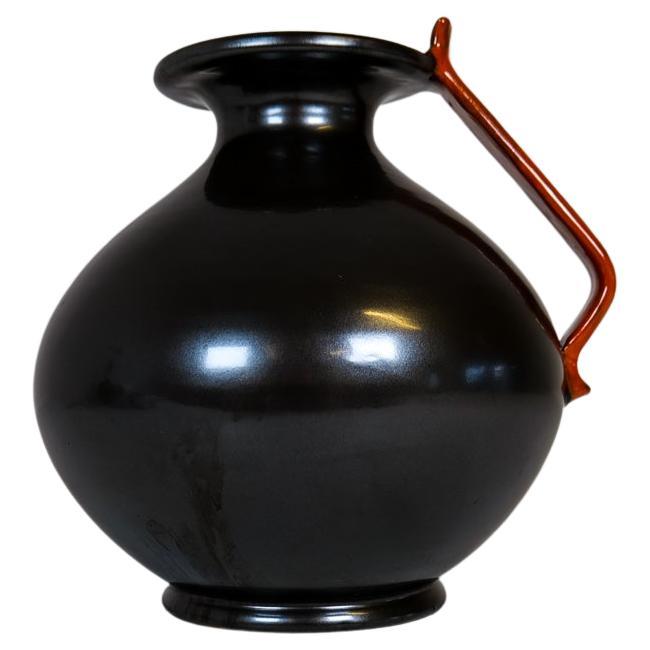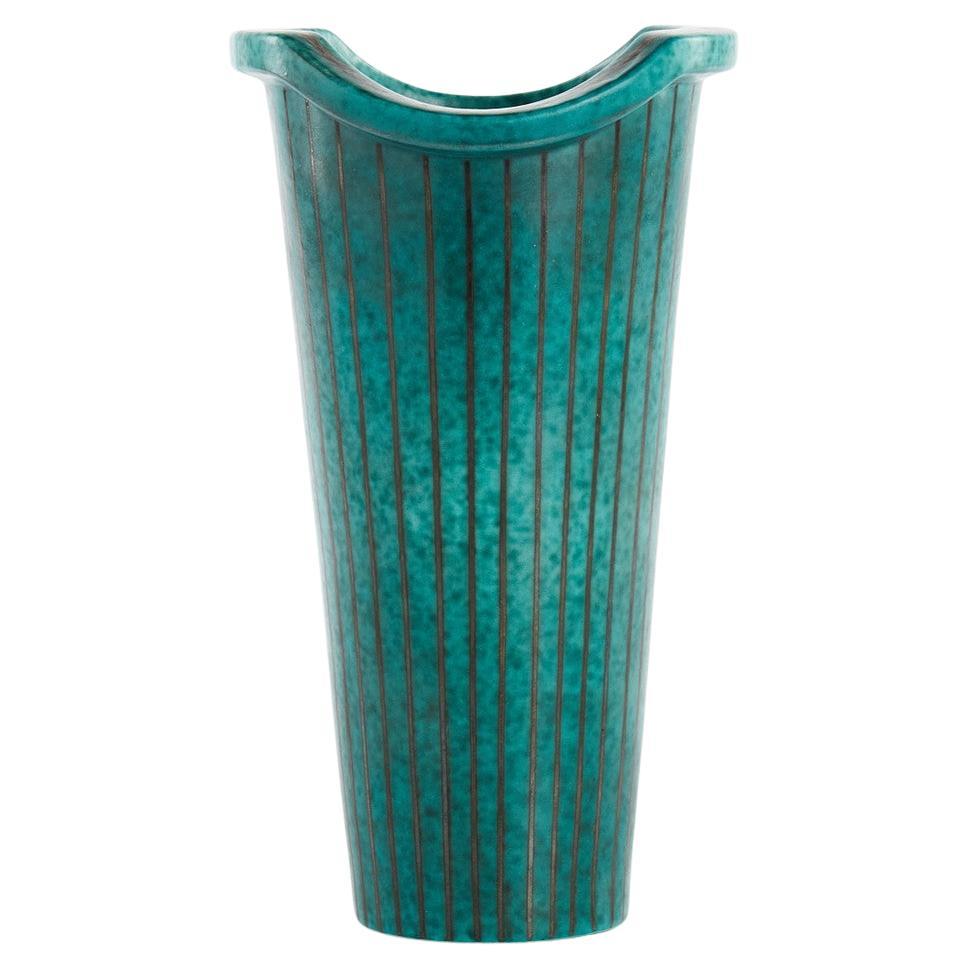Items Similar to Swedish Art Deco Ceramic Fish Silver and Aquamarine Vase, 1947
Want more images or videos?
Request additional images or videos from the seller
1 of 6
Swedish Art Deco Ceramic Fish Silver and Aquamarine Vase, 1947
About the Item
Wilhelm Kåge (1889-1960) is one of the most well-known representatives of the illustrious Swedish ceramic design of the 20th century. This piece is marked "Gustavsberg Argenta 47 Made in Sweden".
Swedish ceramic artist and designer, Wilhelm Kåge (1889-1960) was primarily active in the late-1920s through the 1950s and is best known for his contribution to functionalist style, as well his work as the artistic leader of the Gustavsberg porcelain factory.
Algot Wilhelm Kåge (originally Nilsson) was born in 1889 in Stockholm. Kåge studied decorative painting at the Technical School, later known as the School of Art Konstfack, in Stockholm (never graduating), and subsequently at the Valand Academy in Gothenburg, where he studied under Scandinavian painters Carl W. Wilhelmson and Johan Rodhe.
Between 1914 and 1917, he began designing colorful graphic posters for theaters and exhibitions, becoming one of the first Swedish designers to use posters as a medium for communication. In 1917, Kåge exhibited his posters and his Liljeblå tableware at the Hemutstallningen exhibition at Liljevalchs art gallery in Stockholm, organized by the Swedish Society, the national organisation charged with promoting Swedish design. His tableware caught the eye of Gustavsberg—a well-known porcelain manufactory—and Kåge was offered the job of reinventing their dinnerware service. He was soon appointed artistic director, a position he maintained until 1949, when he was succeeded by Stig Lindberg (1916-1982). During his time at Gustavsberg, Kåge developed new glazes and designs for over thirty different tableware series.
In 1930, Kåge exhibited his Argenta Series at the Stockholm Exhibition. This was his first successful foray in ceramics. The series, which included everything from ashtrays to urns, was glazed in red, brown and blue; but it was the pieces finished in a green glaze with silver adornments that really caught people’s attention. The earliest productions were handpainted by Kåge himself, but demand soon dictated that Gustavsberg expand, and by the late 1930s over 30 people were dedicated solely to the painting of Argenta. The most successful of all Kåge’s works, the series epitomizes the style that became known as Swedish Grace.
A forerunner of democratic design, Kåge used his designs to express his dissatisfaction with certain aspects of Swedish society. His Praktika tableware (1933) was his attempt to alleviate social injustice, by creating functionalist tableware with working-class families in mind. The tableware was, above all practical. It was easy to clean, made for compact storage, and perfect for everyday use. Unfortunately, Praktika wasn’t as popular among his target market as hoped, as many families preferred more conservative, traditional designs. More successful designs include, Pyro (1929), an oven-safe porcelain, and Farsta stoneware (1930), which is considered his best work. The clay for this collection originated from the Farsta Bay, from which the stoneware takes its name, close to the Gustavsberg factory. The pieces from the Farsta collection are regarded today as some of the most influential ceramics to have been produced in Sweden during the 20th century.
Sometime in the 1940s, together with Stig Lindberg and Berndt Friberg, Kåge founded Gustavsberg Studio, where he continued to design until his death in 1960. Kåge passed away at the age of 71 in Stockholm.
Kåge’s work can be found in the National Museum and the Royal Library in Stockholm, the Industrial Art museums in Oslo, Copenhagen, Vienna, Budapest and Prague, and at the Metropolitan Museum in New York . Notably, he was awarded the Prince Eugen Medal in 1949.
- Creator:Wilhelm Kage (Designer)
- Dimensions:Height: 9.06 in (23 cm)Diameter: 4.73 in (12 cm)
- Style:Art Deco (Of the Period)
- Materials and Techniques:
- Place of Origin:
- Period:
- Date of Manufacture:1947
- Condition:Wear consistent with age and use.
- Seller Location:Uccle, BE
- Reference Number:1stDibs: LU6101229058532
About the Seller
No Reviews Yet
Vetted Seller
These experienced sellers undergo a comprehensive evaluation by our team of in-house experts.
Established in 2021
1stDibs seller since 2021
20 sales on 1stDibs
Typical response time: 7 hours
- ShippingRetrieving quote...Ships From: Uccle, Belgium
- Return PolicyA return for this item may be initiated within 3 days of delivery.
More From This SellerView All
- Swedish Art Deco Triple Sterling Fish Aquamarine Vase, 1940'sBy Wilhelm KageLocated in Uccle, BEWilhelm Kåge (1889-1960) is one of the most well-known representatives of the illustrious Swedish ceramic design of the 20th century. This piece is signed with sticker "Gustavsberg Argenta 1079 II". Swedish ceramic artist and designer, Wilhelm Kåge (1889-1960) was primarily active in the late-1920s through the 1950s and is best known for his contribution to functionalist style, as well his work as the artistic leader of the Gustavsberg porcelain factory. Algot Wilhelm Kåge (originally Nilsson) was born in 1889 in Stockholm. Kåge studied decorative painting at the Technical School, later known as the School of Art Konstfack, in Stockholm (never graduating), and subsequently at the Valand Academy in Gothenburg, where he studied under Scandinavian painters...Category
Mid-20th Century Swedish Art Deco Vases
MaterialsSterling Silver
- Swedish Mid-Century Modern Ceramic Vase 1950sBy Wilhelm KageLocated in Uccle, BEThis beautiful piece is part of the artist's "Argenta" Series, produced for the Gustavsberg Factory, which won him his first major success. “Argenta” was introduced at the Stockholm ...Category
Early 20th Century Swedish Scandinavian Modern Vases
MaterialsSilver
- Swedish Art Deco Wilhelm Kage Argenta Turquoise and Silver Vase, 1930sBy Wilhelm KageLocated in Uccle, BEArgenta Vase with nude woman Algot Wilhelm Kåge (6 March 1889 – 25 November 1960) was a Swedish artist and designer, mainly known as a ceramic d...Category
Vintage 1930s Swedish Art Deco Ceramics
MaterialsSilver
- Swedish Modern Wilhelm Kage Argenta Stoneware and Silver Vase, Argenta Fish VaseBy Wilhelm KageLocated in Uccle, BEThe Argenta collection, now emblematic with its green glaze and silver decorations, is one of Wilhelm Käge's most recognizable motifs. Designed in the late 1920s, it was first prese...Category
Mid-20th Century Swedish Scandinavian Modern Ceramics
MaterialsSilver
- Swedish Modern Gunnar Nylund for Rörstrand Ceramic Blue Chamotte VaseBy Gunnar NylundLocated in Uccle, BECreation by Gunnar Nylund (1914–1997) during his tenure as artistic director of Rörstrand from 1932 through the 1950s. The vase has a glossy white glaze over a rough rustic body crea...Category
Early 20th Century Swedish Art Deco Ceramics
MaterialsStoneware
- Swedish Modern White Ceramic Vase by Gunnar Nylund 1950'sBy Gunnar NylundLocated in Uccle, BEThis stoneware vase named "Pike Mouth" by Gunnar Nylund (1914-1997) who was one of Sweden’s most famous ceramic designers. He was the creative director of R...Category
Vintage 1950s Swedish Scandinavian Modern Ceramics
MaterialsStoneware
You May Also Like
- Art Deco Ceramic Globe Vase Ekeby, Sweden, 1930sBy Upsala EkebyLocated in Hillringsberg, SEThis globe vase was manufactured at Ekeby in Sweden 1930s. With its typical of its time globe shape and with a black glaze orange top this vase stands out...Category
Vintage 1930s Swedish Art Deco Ceramics
MaterialsCeramic
- Art Deco Ceramic Vase Bo Fajans Ewald Dahlskog, Sweden, 1937By Bo Fajans, Ewald DahlskogLocated in Hillringsberg, SEWonderful ceramic vase manufactured in Sweden at Bo Fajans and designed by Ewald Dahlskog 1937. The shape and lines of the vase goes perfect with the wonderful glaze. Swirls with da...Category
Vintage 1930s Swedish Art Deco Vases
MaterialsCeramic
- Art Deco Ceramic Vase Bo Fajans Ewald Dahlskog, Sweden, 1937By Bo Fajans, Ewald DahlskogLocated in Hillringsberg, SEWonderful ceramic vase manufactured in Sweden at Bo Fajans and designed by Ewald Dahlskog in 1937. The wonderful swirl lines and sculpture shape of the vase goes perfect with the wo...Category
Vintage 1930s Swedish Art Deco Vases
MaterialsCeramic
- Unique Chamotte Ceramic Vase by Lisa Larson, SwedenBy Stig Lindberg, Wilhelm KageLocated in Stockholm, SELarge and beautiful unique stoneware vase by Lisa Larson. Circa 1980s. Made from unglazed chamotte clay with the inside glazed. Hand made at Lisa Larson studio in Gustavsberg, Swede...Category
Vintage 1980s Swedish Scandinavian Modern Vases
MaterialsStoneware
- Primavera, Art Deco Ceramic Vase, Signed and NumberedBy Atelier Primavera au PrintempsLocated in Mouscron, WHTPrimavera, Art Deco ceramic vase, signed and numbered.Category
Vintage 1930s French Art Deco Vases
MaterialsCeramic
- Art Deco Ceramic Vase by OrchiesBy OrchiesLocated in Paris, FRVery rare stylish minimalistic ceramic Art Deco vase by famous faience factory company "Orchies" founded by two brothers L'Herminé Declercq, Emile and Joseph in Orchies (in Flanders)...Category
Vintage 1920s French Art Deco Vases
MaterialsCeramic





